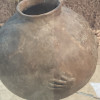
Neolithic European Vinča Symbolism
Art, Education, Symbols and Signs, defaultExploring Starčevo Culture's archaeological art and symbols Nataša Pantović
The Earth Fertility of old Europe
The archaeologists identiied amazing 120 Starčevo settlements in the region around the rivers Sava, Danube, and Drava.
"Late Neolithic Culture Vinča sites" is the term now used to identify the archaeological complex of people, and cultural heritage that belonged to ancient civilization settlements in Serbia, western Bulgaria and southwestern Romania.
Early Neolithic settlements in the northwestern Balkans were usually located in valleys of major rivers, on fertile land. Archaeological evidence indicates that, during the Early Neolithic, settlements were relatively small. They consisted of small rectangular houses made of wattle and daub.
In western Romania, more than 300 Early Neolithic sites have been identiied, in the region of Šumadija in Serbia, around a 200 Starčevo Culture sites have been noted, while in tHungary, there are 230 sites. The site size varies from 0.2 ha to as large as 12 ha.
So far, only a few Early Neolithic settlements have been excavated.
The excavated settlement in Serbia, called Biserna Obala-Nosa near Subotica is from the Starčevo-Körös Culture, with several houses and as many as forty storage pits. Pit walls were covered with clay. The Neolithic community using this settlement was sedentary, and the settlement was long-lived.
Their above ground houses were diferent from the traditional Neolithic architecture in southern parts of the Balkans. Within the Starčevo settlements the majority of ovens, fireplaces, were located in the open. Various zones for comunal or ritual purpose were identified. Distinct areas represent houses, spaces for production of pottery, or stone tools, food storage places had been also identiied.
The setting up of the Starčevo Culture settlements in Bosnia are linked to the exploitation of the salt mines.
At first, these were settlements which today look like hills of various sizes. In Sesklo in Thessaly (Greece) the excavation of the hill of Kastraki has revealed a tell type settlement from the Early and Middle Neolithic. In the history of archaeology, archaeologists of all nations had explored these artificial hills.
The prominent position of the hill and their history, including the social memory, have in Balkan's countries revealed the Neolithic communities and their ancient settlements.
The tells and flat settlements often had coexisted, surrounded with an established social and economic network, and bound by identity.
The collective identity of Neolithic groups is evidenced, bound by a trench, or a dry wall, in south-eastern Europe, during the Neolithic, fortiications were rare. Putting up fortiications as defence against wild beasts also has a symbolic role, separated nature from culture.
Archeologists and sociologists emphasize that the houses were set in a circle surrounding a public space or a large central dugout or fireplace.
Archaeological excavations in Slavonski Brod, measured areas of 6200 m², in Galovo over 2200 m², and Tržnica in Vinkovci, over 12000 m². In Galovo, radiometric measurements indicate that the construction of the Neolithic settlement was done in several phases, while in Tržnica in Vinkovci, the evidance suggest a single layer settlement In Vinkovci, another house from the Starčevo Culture has been excavated.
At the famous Neolithic site of Çatalhöyük in central Anatolia, we find a different story, dating from 7400 - 6 200 BC, houses were built like honeycomb – they shared walls. The way in was an opening in the roof, which was also the only source of light.
In contrast to the Near East and Anatolia, in Vinča, people favoured timber as the construction material. With mudcovered wickerwork, with a north-west to south-east orientation and dozens of metres between each house. The area surrounding the long houses was used for production of pottery, used as gardens, farm yards or places in which other daily activities were taken place. The area adjacent to the houses was sometimes used for burials, usually children.
Visit to Vinča Neolithic Settlements Serbia video
On their Radmilovic estate at Vinča Serbia, the University of Belgrade's Faculty of Agriculture had built a replica of the prehistoric fishermen's village within Mali Dunav (Little Danube). The houses were reconstructed on the basis of archaeological and etno-archaeo data. The project was managed by an architect, a master builder in traditional materials, an archaeologist, & the curator of the Belgrade City Museum. For the reconstruction of houses a traditional mix of clay (30%), sand (40%), and chaff (30%) was used.
Learning from Cattle to settle Bull to rule by Miloš Spasić
Symbolism of Bull
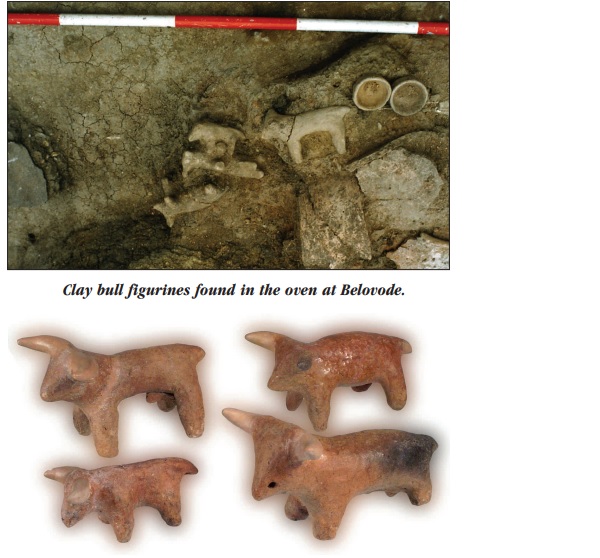
Clay bull figurines found in the oven in Belovode Neolithic Serbia
"Bovine iconography is one of the most important components for understanding social identities among Neolithic Vinča culture communities." Miloš Spasić
“a bucranium is a cattle skull plastered with clay. It is most frequently part of the house inventory, placed inside the house or hung on theouter wall... There are numerous examples of re-plastering, re-modelling and modification of bucrania in Neolithic houses... During the later Vinča culture the artifacts excavated portable bucrania. According to the current evidence, at least 30 bucrania have been retrieved from Vinča culture settlements in Serbia.” Cattle to settle Bull to rule Miloš Spasić
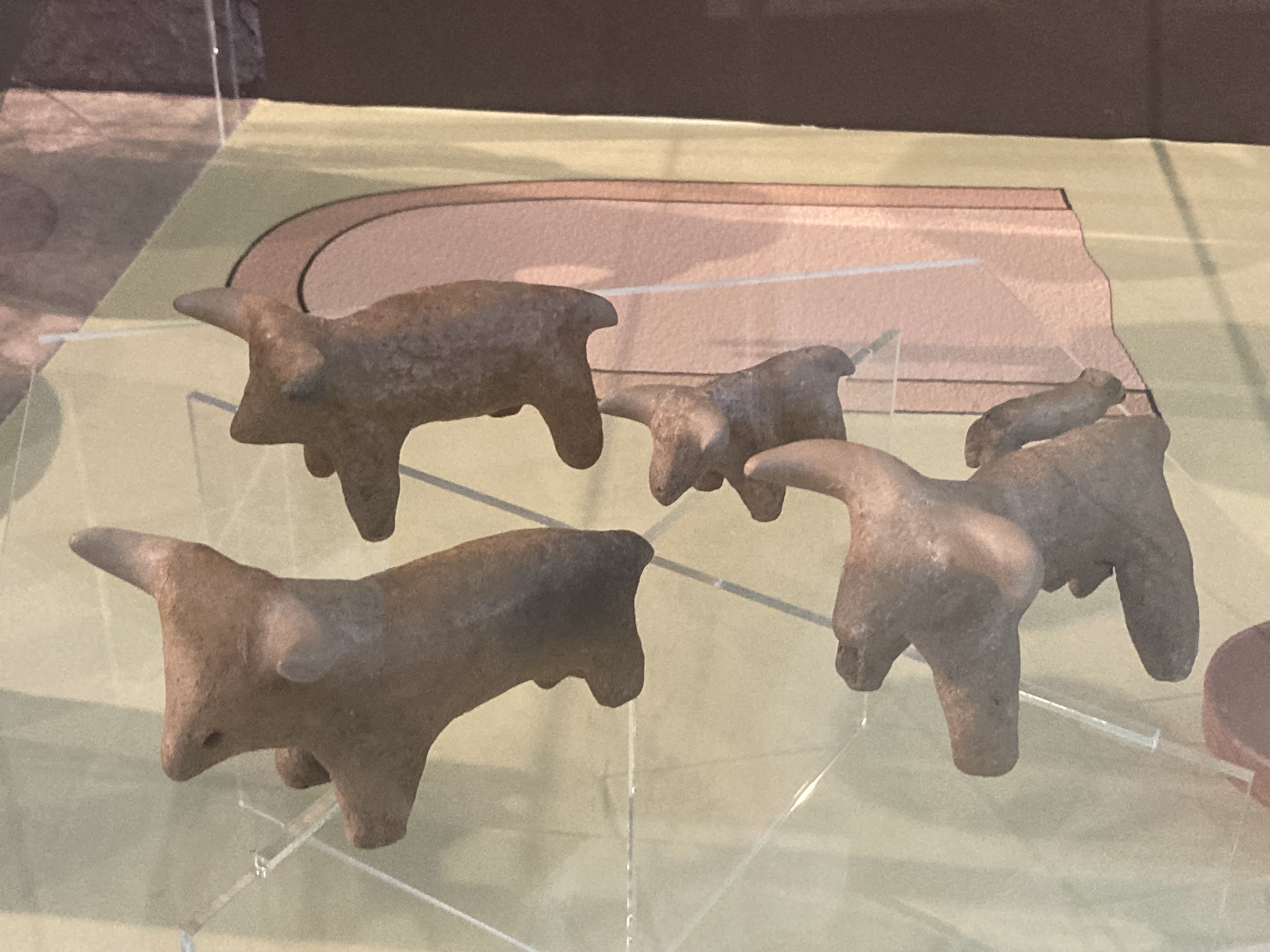
Portable bucrania, bulls, in Serbian volovi, Neolita Vinca Beograd 5000 BC National Museum Belgrade
The archaeologists have also excavated small bulls with horns made entirely of clay, sometimes not larger than a human fist. In the houses larger bulls where the head is modelled entirely from clay, and real horns were added on the top.
There are numerous examples of bucrania being placed in other contexts also, such as burials, house foundation deposits, pits etc. (cf. Russell 2012.99, 106).
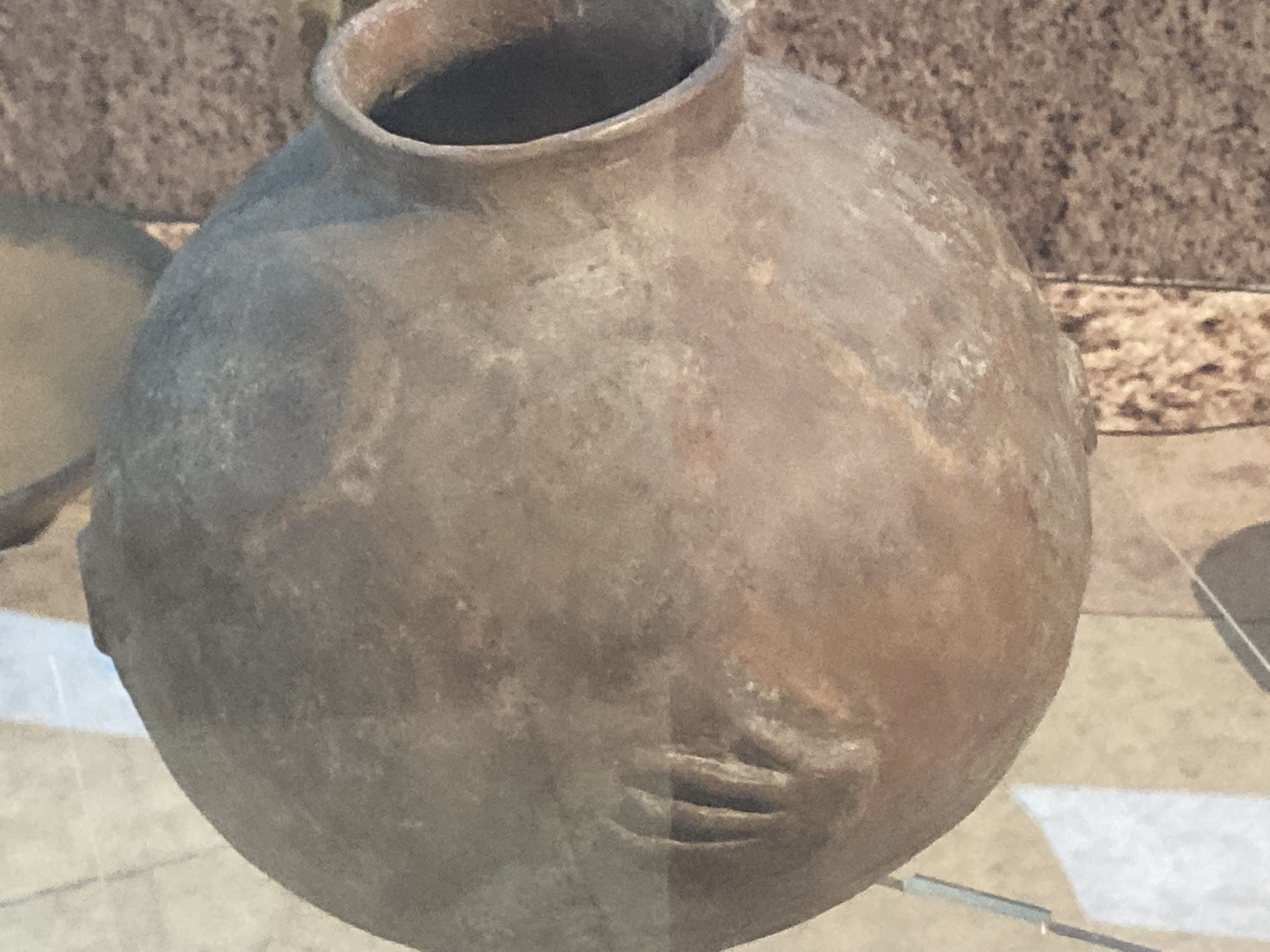
Large ceramic pot Vincha Neolithic Settlement Archaeological Collection of National Museum of Belgrade
Banjica Archaeological Discoveries
Banjica, Belgrade is a multi-layered settlement with age corresponding to the middle and late phase of Late Neolithic Vinča culture. The Neolithic settlements at Banjica could be dated to the period 4900 – 4600 BC. Three sets of entirely preserved cattle horns were found in the southern room of house. The house is rectangular, with three rooms. The southern room contained a small oven and numerous ceramic vessels for storing.
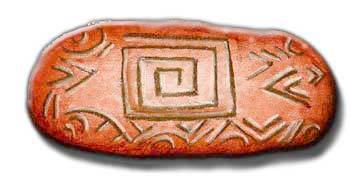
Ancient Bread with Spiral stone Vincha Archaeological Artifact found in Banjica
Gomolava is an archaeologicall site dated to 4950–4650 BC, on the bank of the Sava River, near the village of Hrtkovci. The site was occupied from the Late Neolithic until the Roman period. Eight bucrania were recovered from the 1955 – 1980 excavations.
Stubline is a multi-layered Late Vinča site on an elevated slope. A geo-physical survey revealed an exceptionally well-preserved settlement, with more then 200 above-ground houses and circular ditches surrounding it ).
"One bucrania made entirely of clay was found in house 1/2008. The house is rectangular, with no apparent subdivision of rooms. The house inventory was remarkably well-preserved, with two ovens, a quern, a clay structure for cereal storage (interpreted as an altar in the initial publication), dozens of ceramic vessels, 43 figurines and 11 miniature tool models. The bucranium was found in the central part of the house, and is quite unique." Miloš Spasić
"Clay is the most frequently used raw material for the production of both human and animal figurines in Vinča culture. Only one type of extremely schematisedzoomorphic figurine was modelled in stone."
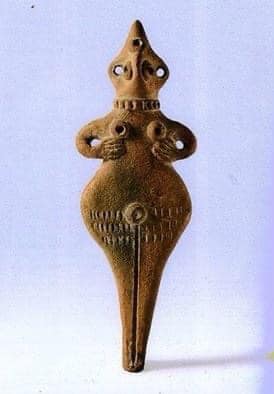
Neolithic stone mini figurine Goddess Serbian Archaeological Settlement 2000 BC National Museum Belgrade
"It should also be stressed that detailed representations of any anatomical characteristics such as eyes, mouth, teeth, fur, skin, or claws are absent in the whole corpus of animal figurines in Vinča culture."
Vincha Neolithics Symobol of 2 (Two)
"As in no other Neolithic contexts, we can clearly delineate the concept of opposed structures in Vinča culture: ‘inside/ outside; domestic/wild; female/male; domus/agrios; human/animal’."
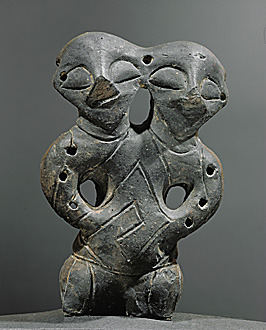
Twins Stone Artifact Vincha Culture Stone Symbolism 3200 BC
"The population of these was several hundred, or even several thousand, and their organization was to emphasize family or build a house, and to develop collective identities, share food, build laws, have rituals."
Learning from GIFTS OF THE EARTH ‑ Neolithic between the Sava, Drava and Danube
Clay and stone were important raw materials all over. An important role was played by mudbrick – brick made of clay mixed with water and organic and inorganic admixtures (chaf, crushed shells, pottery etc.) and dried in the sun – laid on stone foundations. Mudbrick was an original Neolithic invention, because pre-Neolithic communities in that region had not used it.
The introduction of ceramic vessels was suggested to occurred first at 19 200 – 18 800 BC in Xianrendong Cave in Southeastern China. In Japan, it appeared at 14 000–13 100 BC. In the Russian Far East, 15 990 to 7710 BC. In western Siberia, 8300 to 6400 BC .
Further to the west, in the Western Urals and Middle Volga River, the earliest dates, based on freshwater mollusc shells, range between 8300 and 7300 BC.
The data indicate that ceramic technology was invented and reinvented more than once in diferent Palaeolithic and Neolithic contexts.
Quotes from GIFTS OF THE EARTH ‑ Neolithic between the Sava, Drava and Danube
"The earliest pottery productions in Southeast Europe are embedded in time spans at c. 6500–6200 cal BC in the southern Balkans and Peloponnese, at c. 6440–6028 cal BC in the northern and eastern Balkans."
"At Lepenski Vir, vessels were contextualised within hunter-gatherers’ burial practices and symbolic behaviour. They were placed in trapezoidal built structures, and associated with stone sculptures, neonate burials and secondary burials (or depositions) of human and dog mandibles."
"Pottery in the northern Balkans was consistently manufactured according to a single recipe, using non-calcareous micaceous clay pastes, characterised by ine well-sorted alluvial quartz sand with feldspar, and heavily tempered with organic matter (i.e. chaf). In the Adriatic, however, pottery was heavily tempered with crushed calcite on the east coast, and with mineral resources (e.g., lint) and grog (recycled pottery) on the west coast (Spataro 2009; 2011). From the outset in the Aegean, pottery was made locally at a number of sites and exchanged regularly between neighbouring settlements."
"In Central Europe, in Gravettian at Dolní Věstonicean, an assemblage of 16 000 ceramic objects have been found. The statistics indicate that almost all the figurines and statuettes were deliberately fragmented,"






Neolithic European Vinča Symbolism No comments on Neolithic European Vinča Symbolism: